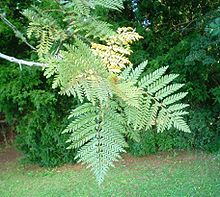Lomatia ferruginea
| Lomatia ferruginea | |
|---|---|

| |
| Scientific classification | |
| Kingdom: | Plantae |
| Clade: | Tracheophytes |
| Clade: | Angiosperms |
| Clade: | Eudicots |
| Order: | Proteales |
| Family: | Proteaceae |
| Genus: | Lomatia |
| Species: | L. ferruginea |
| Binomial name | |
| Lomatia ferruginea | |
Lomatia ferruginea, commonly known as fuinque, is a small evergreen tree in the family Proteaceae.
It is native to southern Argentina and Chile,[2] the Patagonia region of South America. In Chile it grows from Curicó Province to Magallanes (35 to 49°). It is found mostly in deep and moist soils.
Description
Lomatia ferruginea grows to 6 metres (20 ft) tall. It is evergreen, with few branches, newly shoots are covered in reddish-brown hairs. Composite, bipinnate, fern-like opposite and petiolate leaves, 13–14 cm long and 8–10 cm wide, green above and reddish-brown below.
The flowers are hermaphrodite and pedicellate, 2 cm long, in racemes shorter than the leaves, made up by 14-16 opposite flowers, grayish-yellow in bud, every flower is formed by 4 tepals which are oval lanceolate bicolor, reddish brown with green apex, then thinned and again wide at the concave apex of 1.5 cm long, with sessile anthers at the concave apex of the petals, long style, red bulky and oblique stigma.
The fruit is a woody dark brown follicle, 3.5-4.0 cm wide and 1 cm long, made up by two valves, thin pedicellate, like a peduncle downwards, upwards prolonged at the style, it has many imbricate seeds, winged and truncated at the tip, 1.5 cm wide and 0.5 mm.
Taxonomy
Antonio José Cavanilles first described the species in 1798 as Embothrium ferrugineum.[2][3] In 1810, Robert Brown transferred it to the genus, Lomatia.[4]
The genus name Lomatia comes from the Greek lomas, because of the seed's edge, and ferruginea from Latin, meaning ferrous or rusty, referring to the reddish-brown color in new buds.
Cultivation and uses

The wood is valued for its grain and is much used in carpentry. It is highly valued as an ornamental tree in Chile. It has been planted in Scotland.[5] and in the Faroe Islands, where it regularly self-seeds[6]
References
- ^ Prance, G. (2020). "Lomatia ferruginea". IUCN Red List of Threatened Species. 2020: e.T113179050A113310323. doi:10.2305/IUCN.UK.2020-1.RLTS.T113179050A113310323.en. Retrieved 27 November 2022.
- ^ a b "Lomatia ferruginea (Cav.) R.Br. | Plants of the World Online | Kew Science". Plants of the World Online. Retrieved 2023-12-10.
- ^ Cavanilles, A.J. (14 May 1798). Icones et Descriptiones Plantarum. Vol. 4. p. 59, t. 385.
- ^ Brown, R. (8 March 1810). "On the Proteaceae of Jussieu". Transactions of the Linnean Society of London. 10 (1): 200.
- ^ "Lomatia ferruginea". The plant press. Archived from the original on 2009-11-14. Retrieved 2010-04-01.
- ^ "Kunning um viðarvøkstur".
Extermal links
- "Lomatia ferruginea ". Enciclopedia de la Flora Chilena. Retrieved 2010-03-28.
- "Lomatia ferruginea". Chilebosque. Retrieved 2010-03-28.
- "Lomatia ferruginea". Patagonian plants. Retrieved 2010-04-01.

